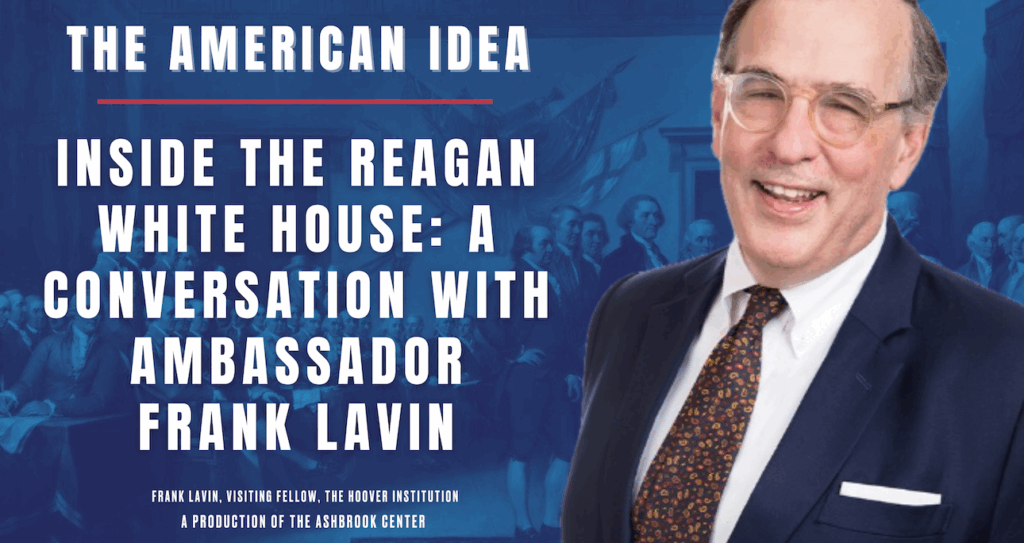Inside the Reagan White House
July 16, 2025

Listen and subscribe to the podcast
Join The American Idea’s Listener Email list – get news about upcoming episodes and a chance to offer questions for them, too!
Ambassador Frank Lavin’s firsthand account of serving in Ronald Reagan’s administration offers a rare glimpse behind the carefully constructed public image of America’s fortieth president. Speaking from the unique vantage point of someone who witnessed both Reagan’s triumphs and quiet moments, Lavin paints a portrait that transcends the familiar mythology surrounding the Gipper to reveal the complex realities of presidential leadership during one of America’s most consequential eras. You can get a copy of the book from Amazon.
The Man Behind the Myth
Reagan possessed what Lavin describes as a fascinating duality, simultaneously the most genial person in any room and someone who maintained an almost impenetrable emotional distance. This wasn’t coldness but rather a studied reserve that enabled Reagan to be universally friendly while revealing himself to virtually no one. Even his staff, who worked intimately with him daily, found themselves on the outside of a wall that Reagan had constructed around his inner life.
This emotional architecture served Reagan well in the brutal world of politics. Lavin recalls how Reagan never raised his voice or manifested anger publicly, instead responding to criticism or confrontation with a characteristic grace that could disarm opponents. When crossed, Reagan would simply tighten his facial muscles slightly, a tell that Lavin learned to recognize, before responding with something like, “Well, everybody sees this differently, and I’m not sure we agree with your point.” This ability to deflect without antagonizing became one of Reagan’s most potent political weapons.
Perhaps most remarkably, Reagan’s private philosophy aligned seamlessly with his public positions. There was no gap between the Reagan who spoke to the Rotary Club and the Reagan who met with congressional leaders behind closed doors. This consistency wasn’t political calculation but authentic conviction, a rarity in a profession built on compromise and expedience.
Governing Through Vision and Pragmatism
Reagan understood something that many ideologues miss: having noble goals means nothing without the practical ability to achieve them. Lavin emphasizes that Reagan operated simultaneously in two essential spaces: articulating a compelling vision for America while mastering the mundane mechanics of getting legislation through Congress. This dual competency separated Reagan from politicians who excel at only one dimension of leadership.
The tax cut negotiations perfectly illustrate this approach. Reagan initially sought a thirty-three percent reduction, then modified his position to thirty percent when that proved unworkable, ultimately settling for twenty-five percent. Rather than viewing this as defeat, Reagan recognized that securing twenty-five percent represented a massive victory that moved the country substantially toward his vision. This willingness to negotiate without abandoning core principles enabled Reagan to accumulate legislative victories that more rigid ideologues might have forfeited.
Reagan’s team-building strategy reflected this same practical wisdom. Rather than staffing his administration with strangers, Reagan drew heavily from advisors who had worked with him during his years as a political commentator and writer. People like Marty Anderson and Dick Allen had been testing and refining ideas with Reagan long before he reached the White House, creating an administration with unusual intellectual coherence and personal loyalty.
Cold War Clarity and Moral Leadership
While foreign policy establishments in both parties had largely accepted Soviet permanence, Reagan brought a fundamentally different analysis to the Cold War. He believed the Soviet system was economically bankrupt and militarily overextended, making it vulnerable to sustained American pressure across multiple fronts. This wasn’t warmongering but strategic thinking. Reagan understood that demonstrating American strength would ultimately create opportunities for meaningful negotiation.
The Strategic Defense Initiative exemplified this approach. By threatening to neutralize Soviet nuclear capabilities through satellite-based missile defense, Reagan was essentially telling Moscow that their primary strategic asset—built over decades at enormous cost—could become worthless. This wasn’t mere saber-rattling but psychological warfare designed to force Soviet leaders to confront their system’s fundamental weaknesses.
Reagan’s famous challenge to “tear down this wall” embodied his conviction that moral clarity was itself a strategic weapon. While pragmatists worried about offending Gorbachev, Reagan insisted on highlighting the Soviet Union’s human rights violations because doing so exposed the fundamental illegitimacy of communist rule. By refusing to treat American democracy and Soviet authoritarianism as morally equivalent, Reagan forced global audiences to choose sides in what he correctly understood as a contest between fundamentally different ways of organizing human society.
The Great Communicator’s Method
Reagan’s communication mastery derived not from natural talent alone but from deliberate technique learned during his years in Hollywood and radio. His approach emphasized inclusion rather than confrontation, taking audiences with him rather than lecturing them. This reflected both good manners and shrewd psychology: people respond better to invitations than demands.
His relationships with foreign leaders revealed how personal chemistry could enhance or complicate diplomatic efforts. Reagan developed genuine rapport with Margaret Thatcher, viewing her as an intellectual peer whose counsel he valued. Conversely, his relationship with German Chancellor Helmut Kohl remained formally correct but lacked the warmth that might have enhanced their policy coordination. Language barriers played a role, but so did simple human chemistry, serving as a reminder that international relations ultimately depends on relationships between individuals, not just institutions.
Reagan’s resilience during crises reflected character forged during the Great Depression. Growing up in near-poverty with an alcoholic father taught Reagan that setbacks were temporary and that maintaining perspective during difficult moments was essential for effective leadership. This emotional steadiness allowed him to navigate presidential crises without losing sight of long-term objectives or becoming paralyzed by short-term pressures.
Lavin’s account reveals Reagan as neither the simple-minded actor nor the conservative saint that different mythologies have created, but rather as a shrewd political operator whose success stemmed from understanding that effective leadership requires both compelling vision and practical skill in the art of democratic persuasion.

